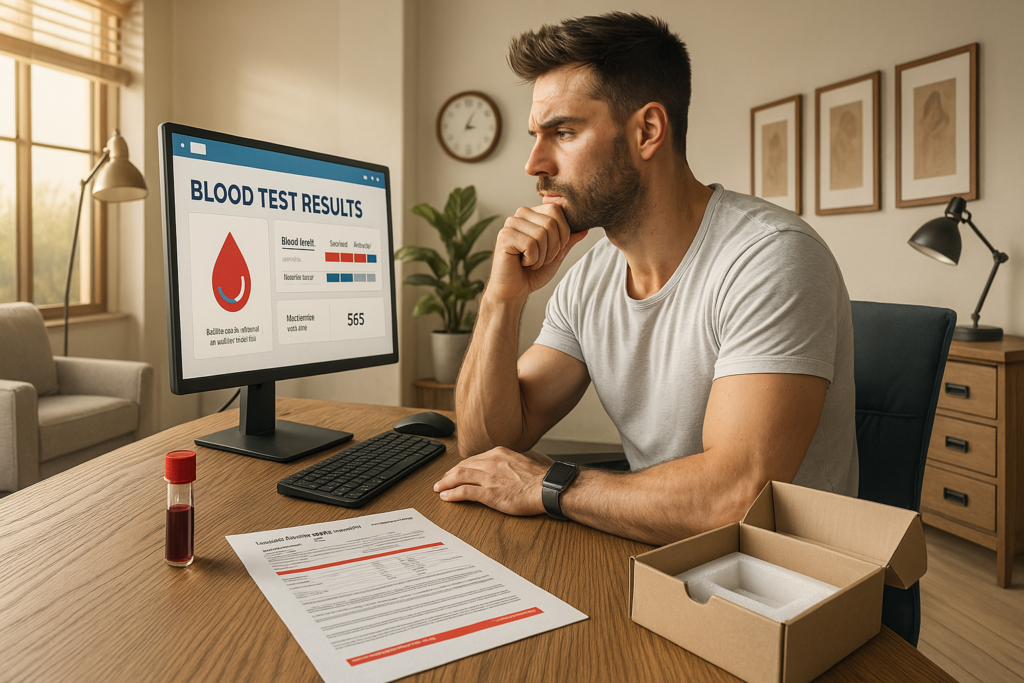How to Get Your Bloodwork For TRT Done (Even Without a Doctor)

Last Updated On March 31, 2025
Starting TRT safely and effectively begins with understanding your body’s current hormone levels. Bloodwork is an essential step in this process, offering critical insights into your testosterone levels and overall health.
But what if you don’t have access to a doctor or prefer to take matters into your own hands? Here’s a guide to help you navigate blood testing for DIY Testosterone Replacement Therapy (TRT).
Why Bloodwork Is Crucial for TRT
Before starting TRT, it’s essential to know where you stand. Blood tests provide the data needed to:
- Confirm low testosterone levels (hypogonadism).
- Identify underlying health conditions that may be causing low testosterone or affect treatment.
- Monitor your progress and adjust doses safely over time.
Skipping this step can lead to improper dosing, ineffective treatment, or serious health risks.
Essential Blood Tests for Pre-TRT
If you’re considering DIY TRT, start by testing these critical markers:
- Total Testosterone: Indicates your overall testosterone levels.
- Free Testosterone: Reflects the amount of testosterone available for your body to use.
- Estradiol (E2): Monitors estrogen levels, which can rise during TRT.
- SHBG (Sex Hormone-Binding Globulin): Helps understand the balance between free and bound testosterone.
- LH (Luteinizing Hormone) & FSH (Follicle-Stimulating Hormone): Identifies whether your low testosterone is primary (testicular) or secondary (pituitary).
- CBC (Complete Blood Count): Monitor blood markers like Hematocrit and Red Blood Cell Count, which can rise during TRT.
- Liver Function Tests: Confirms your liver can handle TRT.
- Lipid Panel: Checks cholesterol levels, as TRT can impact them.
Having these results allows you to tailor your treatment and establish a baseline for future comparisons.
How to Get Bloodwork Without a Doctor
Getting bloodwork without a doctor’s prescription is easier than ever. Below are your options for obtaining blood tests, listed from least expensive to most expensive:
1. Local Private Clinics and Hospitals
In many regions, private clinics and hospitals offer blood testing at lower costs compared to other options. Call ahead to confirm whether you need a referral. These facilities often provide a more affordable alternative, so always check locally before exploring other methods.
2. Travel for Affordable Labs
If testing options in your area are limited or costly, consider traveling to nearby states or countries with lower lab fees. This option can be especially cost-effective in regions where lab costs are significantly inflated.
3. Home Testing Kits
Home test kits let you collect blood samples yourself using a finger-prick device. These kits are typically less expensive than direct-to-consumer labs and offer the convenience of testing at home. While they may be less comprehensive than traditional lab testing, they can measure key hormones like testosterone and estradiol. Examples include:
- LetsGetChecked
- Everlywell
While these tests may seem more convenient and cheaper, their accuracy isn’t great and most TRT specialists advise against them.
4. Direct-to-Consumer Labs
Direct-access lab services allow you to order tests online and visit a local lab for a blood draw. These services provide results directly to you, typically within a few days.
By choosing the right option for your budget and location, you can take control of your health and get the blood tests you need without a doctor’s prescription.
Best Practices for Bloodwork
To ensure accurate results:
- Test in the Morning: Testosterone levels peak between 7-10 AM.
- Fast for 8-12 Hours before testing: Fasting improves the accuracy of lipid and hormone panels.
- Avoid Heavy Exercise: Strenuous workouts can temporarily alter hormone levels.
- Minimize Alcohol: Avoid alcohol for at least 24 hours before testing.
Interpreting Your Results
Once you receive your blood test results, use them to guide your TRT plan. Online resources, forums, or professional consultations can help you understand the numbers. Look for ranges that align with healthy and optimised levels, and adjust your protocol accordingly.
You can also make use of our complete beginner’s to bloodwork for TRT to help clarify and simplify everything.
Regular Testing After Starting TRT
Bloodwork isn’t a one-and-done task. To track your progress and maintain safety, retest regularly:
- 6-8 Weeks After Starting: Assess how your body is responding.
- Every 3-6 Months: Monitor ongoing levels and adjust your protocol if needed.
Avoiding Pitfalls in DIY Blood Testing
- Overlooking Key Markers: Ensure your panel covers more than just testosterone to avoid missing critical health indicators.
- Neglecting Follow-Ups: Hormone levels fluctuate; regular testing ensures sustained success.
- Misinterpreting Results: If unsure, consult a medical professional or experienced TRT community members.
Take the First Step Toward Better Health
Bloodwork is your roadmap to successful DIY TRT. It might seem daunting at first, but with the right approach, it’s both accessible and manageable.
Download our free DIY TRT Essentials Checklist for a complete list of must-have tests and free templates for tracking your progress and lab results.
Take control of your health today!